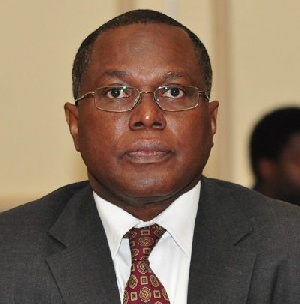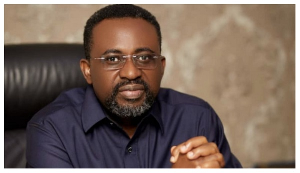Former Director-General of the National Development Planning Commission (NDPC), Dr. Nii Moi Thompson, has hit back at Dr. Tony Aidoo over suggestions the NDC’s 40-year Developmental plan under the erstwhile Mahama government was a waste.
Dr. Tony Aidoo in a radio interview on Starr FM Tuesday described the development plan as ‘nonsense’ adding that it lacked proper planning and proper execution.
He said, “you need data to plan; you look at a community: how many toilets do they have? Potable water availability, how much can we spend to provide those items? What about the neighbourhood community? … All those are matters of data. You don’t plan without data; the so-called 40-year plan that was developed under the Mahama administration was to me, nonsense. How do you plan without data?”
But in a response to claims by the NDC stalwart the former head of the NDPC, Dr. Nii Moi Thompson, says Tony Aidoo appears to be in a state of confusion as to the work of the NDPC.
Dr. Nii Moi Thompson in a statement said “if he is quoted correctly, then he seems to confuse his rather unpleasant experience with the Policy Evaluation and Oversight Unit set up for him at the Presidency by UNDP to compete with NDPC, which is the sole state agency constitutionally mandated to coordinate M&E at the national and local levels. ”
He adds, “At the time, Dr. Aidoo often complained bitterly and publicly about his inability to obtain data from MDAs. There was a reason for that: They were under no legal obligation to share such data with him. NDPC, on the other hand, had no such difficulty, having long established systems for obtaining data from the same MDAs, which are legally required to provide them.”
Read below Dr. Nii Moi Thompson’s full reply to Dr. Tony Aidoo on the 40-year development plan
It’s doubtful that Dr. Aidoo has seen the plan, much less read it or studied the process of preparing it. And if he is quoted correctly, then he seems to confuse his rather unpleasant experience with the Policy Evaluation and Oversight Unit set up for him at the Presidency by UNDP to compete with NDPC, which is the sole state agency constitutionally mandated to coordinate M&E at the national and local levels.
At the time, Dr. Aidoo often complained bitterly and publicly about his inability to obtain data from MDAs. There was a reason for that: They were under no legal obligation to share such data with him. NDPC, on the other hand, had no such difficulty, having long established systems for obtaining data from the same MDAs, which are legally required to provide them. NDPC used the data and information from the MDAs to prepare its annual progress reports (APRs), which were submitted to (and continue to be submitted to) the president and parliament.
The fact that Dr. Aidoo failed in getting information from MDAs that refused to submit to the authority of his donor-funded ad hoc office does NOT mean there was no data; there was and there is. Anyone serious about getting “data” on Ghana can easily access any of the annual progress reports, in addition to the large reservoir of data at government sites like GSS, MOF, and BOG, to name but a few. Compared to countries at similar stages of development, Ghana has a fairly good data reservoir and system, although there’s always room for improvement.
Perhaps, more importantly, Dr. Aidoo seems to confuse operational (annual/medium-term) plans with a long-term plan, which is more aspirational, a VISION of the future, with high-level targets and strategies and policies for achieving it. You don’t have to cost that. Rather, it guides the preparation of the operational plans, which are then costed and budgeted for.
The distinction is not trivial. Nor, out of intellectual double-talk, can we trivialise the importance of long-term planning.
To quote from Kwame Nkrumah’s 7-Year Development Plan, the transformation of the Ghanaian economy could only occur over the long term and for that we needed a long-term plan. To fail to plan long term, according to the 7YDP, was to remain “prisoners of our past”. And we see evidence of this all around us.
Every major problem we face in Ghana today is the result of our failure to anticipate the future, no matter how imperfectly, and plan for it accordingly. Housing policies, education policies, transportation policies, etc all require a view of the long term, and in particular population growth, levels and distribution.
The 7YDP, for example, was the first to propose free secondary education in 1963 and, on the basis of that, prepare for the construction of more secondary schools. (See quote at the end).
The coup of 1966 ended that plan and placed us on the path of ad hoc development planning, with dire consequences. A story in the 19th September, 1969, issue of the Daily Graphic reported that of the 50,000 students who passed the Common Entrance Exam that year, “only 10,000 .. will be admitted to various secondary schools” because of limited space.
This is exactly what the 7YDP sought to avoid. Yet, nothing was done about it, and we went about our national lives with reckless abandon. More recently, in 2006 or thereabout, a team of educators appointed to offer solutions to the problem of inadequate space in our secondary schools rather cynically proposed to LIMIT ACCESS to these schools. As a result, government set the pass rate of BECE at no more than 60%, and even then most of those who passed still couldn’t get into secondary schools.
It’s good that free secondary education was eventually launched in 2017, 54 years after it was first proposed. But the chaos that attended its implementation, the risk of diluting the quality of education as a result of the double-track system to address the problem of inadequate space, and the fact that we have not fully worked out its full implications for national development in the immediate and distant future, is a reminder that we will indeed remain prisoners of our past until we boldly face the future and plan for it.
The future will NOT wait for us because someone thinks we don’t have data. Others, such as South Korea, did even greater things with less data. We have absolutely no excuse for not planning, data or no data.
Lastly, I must inform Dr. Aidoo that the long-term plan has other associated plans: 1. The Ghana Infrastructure Plan, which, among other things, will ensure that all open gutters are covered by a certain date, every city and town has modern sewage systems, and every community road is paved; provisions for dealing with floods and erosion, addressing the housing deficits, and even anticipating charging stations for the advent of electric cars in Ghana; 2. The Spatial Development Framework, which will rationalise and sanitise human settlements development to prevent the whole country from becoming one huge sprawling slum; 3. A national human resource development policy and strategy to ensure that we provide education and training today according to the projected pace of growth and structure of the Ghanaian economy; and 4. The most comprehensive model of the Ghanaian economy to enrich policy making.
I encourage Dr. Aidoo to study these and the plan proper to get a better sense of what actually transpired and what is at stake.
Nii Moi Thompson, Accra
PS: Quote from Seven-Year Development Plan, 1963/64-1969/70
“It is intended that by the end of the Seven-Year Development Plan secondary education will also have become free”.
…
“The estimated large increase in enrolment in secondary schools will require the construction of many more schools. To reduce such capital outlay to its lowest possible ?evels, every effort
will be made to expand existing schools in preference to building new ones and to construct as many day-secondary schools as possible.
…
“Starting from 1963 school text-books will be supplied free of charge…”
It is important to note that one of the first acts of the NLC was to abolish the free textbooks policy, along with the Plan. The result of course is the mess that we find ourselves in today.
General News of Tuesday, 20 November 2018
Source: newswiregh













